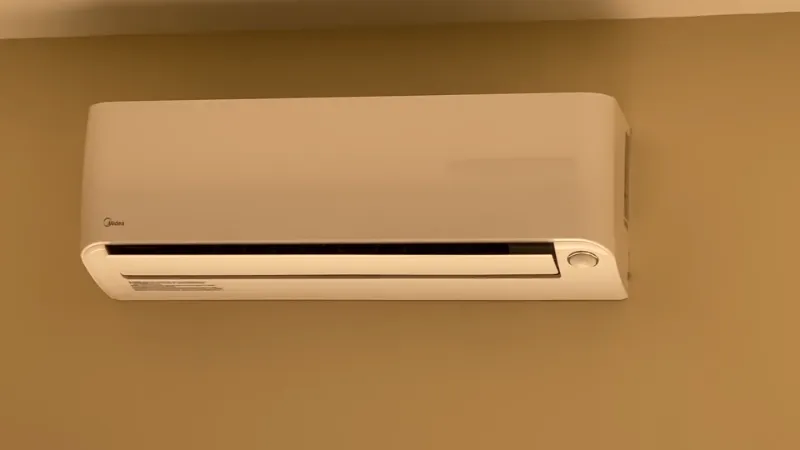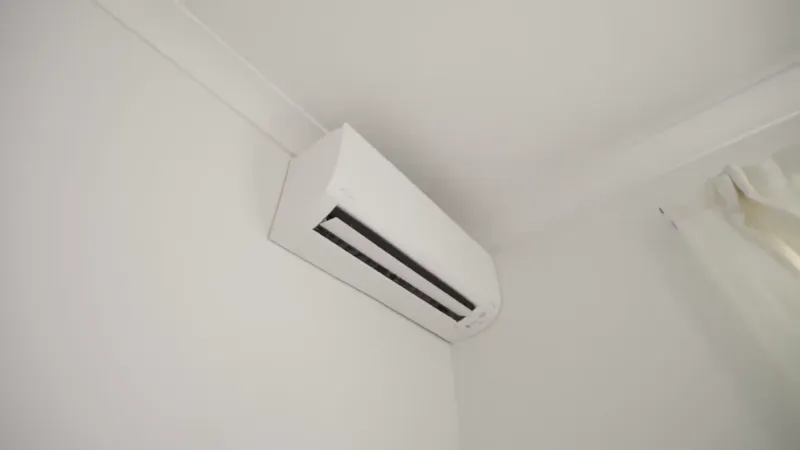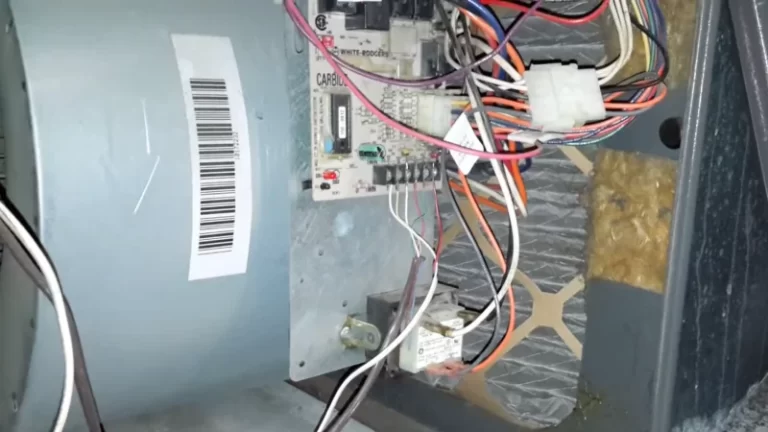Should There Be Styrofoam In My Air Conditioner? [Pros and Cons]

Styrofoam is a lightweight and versatile material used in many applications. It is widely used in insulation and packaging and is also found in air conditioners. In recent years, there has been an increased focus on the environmental impacts of styrofoam and its disposal, leading to the question of whether or not styrofoam should be used in air conditioners.
This article will explore the pros and cons of using styrofoam in air conditioners.
You'll Learn About
Should There Be Styrofoam in My Air Conditioner?
Styrofoam is a popular foam-like material made from polystyrene. It is light-weight and low-cost, making it a popular choice for insulation and packaging. It is most commonly used to insulate buildings and keep food fresh.
Should Styrofoam Be Used in Air Conditioners
Using Styrofoam to insulate air conditioners has its advantages. It is lightweight and easy to install, and it can help reduce noise when the air conditioner is running. However, there are some drawbacks to using Styrofoam in air conditioners.
One of the main issues is that Styrofoam is not very durable, and over time it can break down and become less effective. Additionally, Styrofoam is a petroleum-based product, and its production has a negative impact on the environment.
Alternatives to Styrofoam
There are a number of alternatives to using Styrofoam in air conditioners. One of the most popular alternatives is fiberglass insulation, which is more durable and provides better insulation than Styrofoam.
Additionally, some air conditioners come with pre-installed insulation, such as wool or cotton batting. Additionally, there are spray-on foam insulation products that can be used to insulate air conditioners. The two-stage air conditioners are also good.
These products are more expensive than Styrofoam, but they are more durable and provide better insulation.
Benefits of Not Using Styrofoam
Not using Styrofoam has many benefits. As mentioned above, using an alternative insulation material is more durable and provides better insulation. Additionally, not using Styrofoam reduces the environmental impact of the air conditioner, as it does not require the production of a petroleum-based product.
In conclusion, there are both advantages and disadvantages to using Styrofoam in air conditioners. While it is easy to install and can reduce noise, it is not very durable and has a negative environmental impact.
Therefore, it may be better to choose an alternative insulation material or pre-installed insulation when installing an air conditioner.
Cons
There is no negative effect of having Styrofoam in the Air Conditioner as it helps it to run properly. Styrofoam which is used to insulate the outer surface keeps air and heat out of the system. Styrofoam blocks moisture to build up and hence does not allow mold and mildew to grow which affects the A/C unit.
Styrofoam reduces the need for repairs as it keeps the unit away from any outside forces. The unit is safe from the outside as it will withstand a strong gust of winds which is ideal for any area with high wind. The foam also reduces dust and debris build up which stops the unit from being cleaned as the foam helps the unit to self-clean.
What is the White Stuff in My Air Conditioner?

White slime is a type of fungi that can grow in air conditioners. It is often referred to as “slime mold” or “slime fungus”. It is usually caused by a combination of humidity and dust in the air. Slime can clog air filters, reducing the efficiency of the HVAC system.
It can also grow on the evaporator coils and cause damage to the system. Slime can produce a musty odor and can cause respiratory problems for people with allergies and asthma. Proper maintenance is important to avoid a buildup of slime in the air conditioner.
This includes regularly changing the filter and cleaning the evaporator coils. If a buildup of slime is present, it is important to contact a professional to clean the system and prevent future issues.
Regular maintenance can help reduce the risk of slime in the air conditioner and keep your HVAC system running smoothly.
Why is My Ac Blowing White Powder?
The white powder that is being blown out by the air conditioner is a fine mineral powder created as a byproduct of an ultrasonic humidifier. The humidifier uses sound waves to turn water molecules into tiny droplets of mist that are released into the air.
As the mist evaporates, the water molecules combine with minerals and other particles in the air and form a fine white powder.
How Does It Get Into the Air Conditioner
The fine white powder is light enough to be easily carried through the air, so it can easily find its way into the air ducts of the air conditioner. Once inside the air ducts, the powder accumulates on the interior walls and eventually makes its way to the filter.
As the fan spins, it sucks in the powder and blows it out into the air.
Is It Harmful
The powder itself is not harmful and is mostly made up of harmless minerals, but it can become a problem when it accumulates in large amounts. The powder can clog the air filters and reduce air flow, which can cause the air conditioner to work harder and result in higher energy bills.
How Can I Prevent It
The best way to prevent the powder from accumulating in your air conditioner is to use a high-efficiency filter. These filters are designed to trap the particles and keep them from entering the air ducts.
Additionally, you should make sure that the filter is changed regularly to ensure that it is doing its job properly.
How Can I Get Rid of It
If you already have a buildup of the white powder in your air ducts, you can use a vacuum cleaner with a HEPA filter to remove it. Alternatively, you can also use a damp cloth to wipe down the interior of the air ducts to remove any powder that is stuck to the walls.
Should Ac Pipes Be Insulated?
Ac pipes should be insulated to prevent condensation and heat gain. Insulation helps maintain the desired temperature of the refrigerant in the pipes. Insulation also reduces energy loss and helps the system run more efficiently.
It prevents freezing in cold climates, and keeps the pipes from becoming too hot in warm climates. Insulation helps to protect pipes from outdoor elements. Properly installed insulation increases the life of pipes and reduces maintenance costs.
Insulation prevents corrosion or rusting of the pipes. It also helps reduce noise from pipe vibration. Proper insulation helps reduce condensation on the outside of the pipe. Insulating AC pipes is essential for efficient operation and long-term protection of the AC system.
What Does Mold Inside Ac Look Like?
Mold inside an AC unit can appear in a variety of different colors, including black, green-black, brown, green, white, pink, yellow, or orange. It often appears as fuzzy or slimy patches, and can spread quickly if left untreated.
Causes of Mold Inside Ac
Mold inside an AC unit is usually caused by a combination of high humidity levels and stagnant air, which is often a result of poor maintenance. This can lead to moisture buildup and the ideal conditions for mold growth.
Health Risks of Mold Inside Ac
Exposure to mold inside an AC unit can be dangerous for your health, as it can cause a variety of symptoms, including coughing, sneezing, eye and throat irritation, skin rashes, and even asthma attacks.
Prevention of Mold Inside Ac
There are a few ways to prevent mold inside an AC unit, such as regularly changing the air filter and checking the drain pan for debris. Additionally, you should keep the humidity levels in your home under control and make sure to keep the AC unit clean by vacuuming and wiping it down regularly.
Treatment of Mold Inside Ac
If you already have mold inside your AC unit, you should contact a professional for help. They will be able to safely remove the mold and replace any affected parts. Additionally, they may recommend treatments such as the use of a dehumidifier or an air purifier to help reduce the amount of moisture in your home.
What is Toxic in Ac?
Fluorinated hydrocarbons are chemicals used in air conditioners and other appliances to cool air and keep it at a steady temperature. These chemicals are often referred to as Freon, which is a leading brand name.
Freon is a type of chlorofluorocarbon (CFC) or hydrochlorofluorocarbon (HCFC) used in refrigeration and air conditioning systems to cool the air.
How Toxic is Freon
Freon can be toxic to humans and the environment if it is not handled properly. Inhalation of Freon can cause irritation to the eyes, nose, throat, and lungs. High levels of Freon can also cause nausea, dizziness, headache, and confusion.
Prolonged exposure to Freon can even lead to death in extreme cases.
What Are the Dangers of Freon Leakage
Freon leakage is one of the most common causes of air conditioner damage. A Freon leak not only causes the air conditioner to not cool properly, but it can also be toxic. If a Freon leak is not detected and repaired quickly, it can cause harm to the environment and people.
How to Detect Freon Leakage
The best way to detect Freon leakage is to have a professional inspect your air conditioner. A professional will be able to detect any leaks and repair them quickly before they cause any harm to the environment or people.
What Are the Alternatives to Freon
There are many alternatives to Freon that are much safer and more efficient. The most common alternatives are hydrofluorocarbons (HFCs) and hydrofluoroolefins (HFOs). These alternatives are not as dangerous as Freon and do not contribute to ozone depletion.
They are also more efficient and cost effective, making them a great choice for air conditioners.
Is Ac Mold Harmful?
Ac mold is a type of fungus that grows in moist environments, such as those found in air conditioning units. It is made up of microscopic spores that can cause a musty smell and health problems.
Health Risks of Ac Mold
Exposure to ac mold can lead to respiratory issues such as sinus problems, coughing, wheezing, and headaches. People with allergies or asthma may be more sensitive to these spores, leading to an increased risk of infection and other health problems.
How to Identify Ac Mold
Ac mold is typically identified by its musty smell, which may be more noticeable in closed-off spaces such as air ducts and air conditioning units. Visible signs of ac mold growth can include dark spots, discoloration, and a thick layer of dust on the affected surfaces.
How to Prevent Ac Mold
The best way to prevent ac mold is to keep the environment dry and well-ventilated. This includes regularly cleaning and replacing air filters and ensuring the air conditioning system is maintained properly.
How to Get Rid of Ac Mold
If an ac mold infestation is detected, it is important to take action quickly to avoid further health risks. The affected areas should be cleaned with a bleach solution and the air conditioning unit should be checked for any underlying problems.
If necessary, a professional may need to be called in to assess the situation.
To Recap
In conclusion, the use of styrofoam in air conditioners is a controversial issue. On the one hand, it is an effective insulation material that is easy to install and can reduce energy costs. On the other hand, its disposal creates environmental problems and it can become a fire hazard if not properly maintained. But you don’t want to destroy it, right?
Ultimately, the decision to use styrofoam in air conditioners should be weighed carefully in order to ensure the best outcomes for both the environment and the user.

